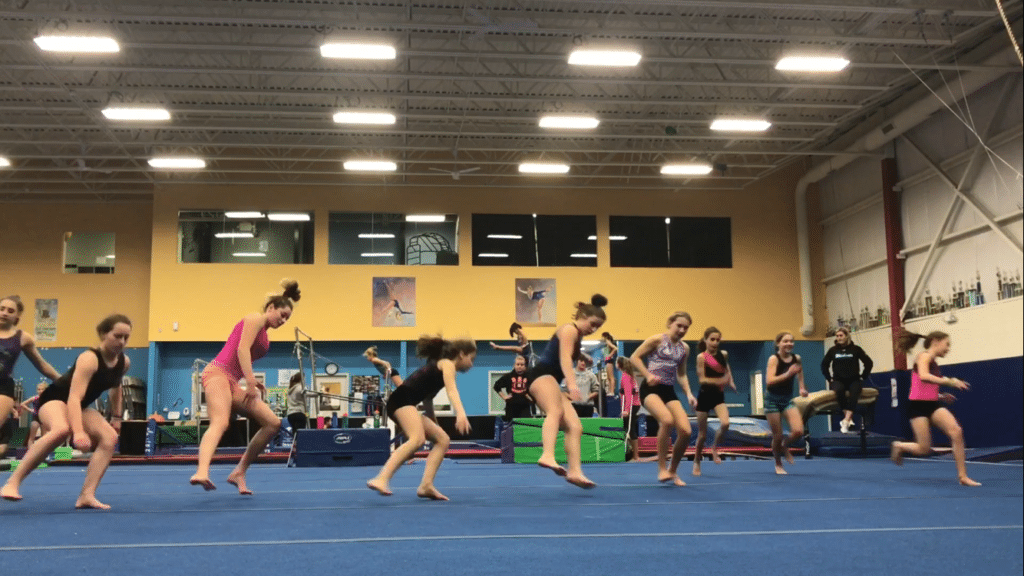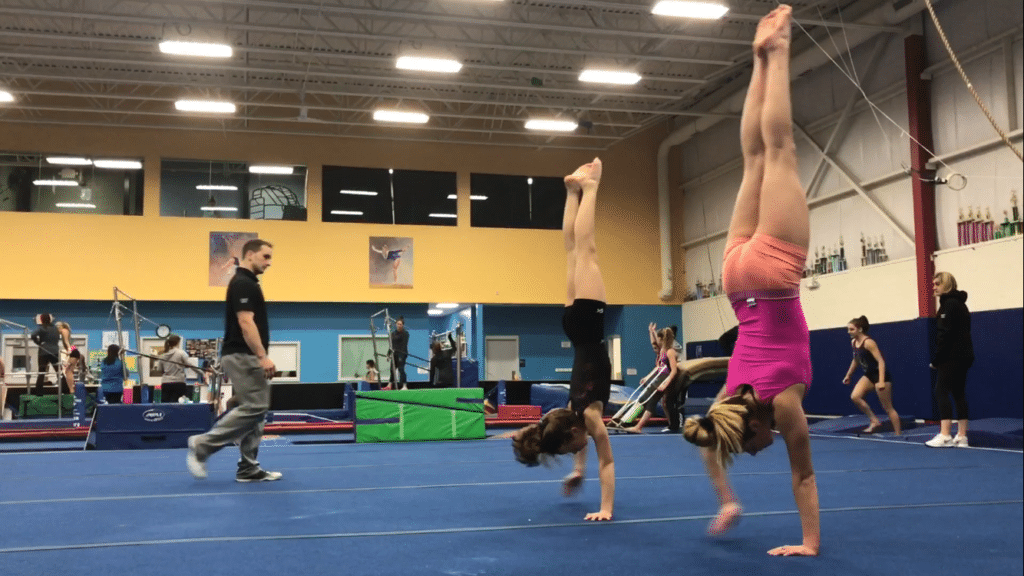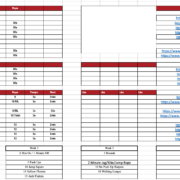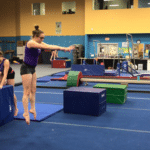3 Of My Favorite Cardio Workouts For Gymnasts During Competition Season
The topic of cardio training is something of huge importance for gymnastics coaches, medical providers, and athletes to spend time learning about. It can be overwhelming for many people if they have not been exposed to the information. To help, I wanted to share 3 of my favorite “frameworks” of energy system workouts I use during the competitive season.
Before you check out the workouts, remember if you want to learn all my current thoughts on cardio training in gymnastics, be sure to download my free ebook, “The Gymnastics Cardio Guide” here,

Table of Contents
The Gymnastics
Cardio Guide
- Outlines the why and how for training cardio in gymnastics
- Explains the basic energy systems, how to train them, and why it's crucial to prepare gymnasts for routines
- Gives sample workouts for summer, fall and in season to use
We take our privacy seriously and will never share your information. Click here to read our full privacy policy.
I do not want to make this post overly complicated with nerdy physiology or mechanisms of energy system training. I know not everyone reading this has that background. Instead, I will share the video examples, explain the workouts, and offer some general points as to why I set the work outs up in a specific way. If you are interested in more depth, continue on past the videos to learn more about the general adaptations, theory, and some concepts of physiology.
Example #1 – Pull Up / Single Leg Jump / Sled Push Relay with Kettlebell Holds
The first example utilizes smaller bursts of upper body and lower body power, but over a longer period of time while factoring in core control under fatigue.
- 10 total monkey pull ups on beam, then 10 single leg block jumps (max height goal)
- A weighted block push lap down and back, as fast as possible
- Then following this quick burst of upper and lower body power, the athlete picks up two kettlebells and held them while in a very fatigued state.
- They did this 3 times each person, in groups of 4/5 so that they could rest about 2x as much as they worked and recover their energy.
Why This Framework is Important
To me, it is the kettlebell hold following the power exercises that is most important. This is where the athlete learns how to maintain body tension and core control in a fatigued state, similar to what we want to occur in a routine. I intentionally set up the workout scheme to have small bursts of upper and lower body (think bar/floor routines) for certain benefits, but I think the core control under fatigue takes priority.
In my mind, developing the physiological and pyschological ability to maintain body tension under fatigue has huge implications for success at the end of a routine. All to often we see great routines end poorly when a gymnast falls on their last skill or dismount. Many times it is because fatigue factored in and the gymnast had lacking shaping or core control. It is also key for injury prevention, as those who lose body control in a fatigued state will have a very tough time doing high level skills safely. An important note, they must know proper deadlifting and body tension / stacking mechanics.
Example #2 – 90 second on / 4 minutes Off Circuit
This workout is based much more on the all out, high intesnsity, and very taxing anaerobic demand seen in a floor, or uneven / high / paralallel bar routine. I design these types of workout to be very similar to the energy demands of routines, but in a more conservative manner that does not use actual higher risk gymnastics skills.
Eventually (as you will see in Example 3) I like to progress these to complex gymnastics skills, but only after they have developed this energy system on a general level over a month in the preaseason. The gymnast can focus on all out intensity with proper movement patterns, to help prepare them for what will eventually be higher intensity floor passes and skills.
- 30 seconds of medball slams (mimicks tight hollow/arch shape change),
- 30 seconds of floor jump cast handstands
- 30 seconds of all out block pushes.
- They did 3 rounds with a much longer 4 minute rest in between due to the intensity.
Why This Framework is Important
It’s really engineered to accumulate lactic acid /metabolic bioproducts within the body, and help teach the gymnast to tolerate this uncomfortable fatigued, acidic state. As many publications outline, we need to provide the appropriate rest ratio (this is even probably too small) to recover the specific creatine phosphagen and glycolytic pathway. I think this circuit has a good balance of core work, upper body biased movements of handstands for events, and then lower body biased movement with upper body holding. Over time from preseason to now, I manipulate a lot of variables based on what our goal is and where we are in the season.
Example 3 – Gymnastics Skill Bursts with “After Burners” For Finishers
This last example is much more gymnastics specific, but with a few different angles added in. The main goal I have with this workout is to transfer the short burst high-intensity environment from above, to a much more gymnastics type situation.
We need to develop this type of capability for ideal routine/meet performance. It is also very important for safety, as the gymnast must be taught how to push through feelings of fatigue and execute high-risk skills for last passes/dismounts.
In this example, the gymnasts do
- 2 back to back tumbling passes to stacked mats
- A lap of handstand walks and broad jumps around the floor before getting back in line to rest
- Following a short break, the gymnasts finished with one all out minute of jump cast handstands and sprints.
The gymnasts do passes to their ability level like twisting or just back tucks, as seen above, and also prioritize quality of the skill over anything else. Each athlete went through 4 rounds of the tumbling, and did the last part together as seen.
Why This Framework is Important
I take the route outlined because I want to make sure we develop this gymnastics specificity and metabolic pathway in a safe environment first, before ever asking athletes to perform demanding high risk workouts (back to back floor routines, multiple events of multiple routines, etc.
Remember, this intensity was not the starting point. This circuit progressed over 6 weeks, with each week adding more difficulty. We increased the tumbling demand (1 basic, then 2 basic, 1 complex, 2 complex, etc) or active recovery exercise (first basic jumps, then handstands/jumps) or after burner intensity (first just push ups, then jump CHS, then sprints, then together). Manipulating these variables helps to accumulate lactic acid and metabolic fatigue at a faster rate, promote different recovery ratios, tax certain muscles groups differently, and so on.
If you just want to take away some useful metabolic work outs, read no further. If you are interested in some more thoughts, keep on trucking.
Bigger Picture Thoughts
The first big take away is to consider the principles, background ideas, and specific energy system intentions for different work outs. It’s not all about just copy pasting the workouts I offered, or making learning some new exercises to try.
It is much more about understanding why certain work to rest ratios are chosen, the physiology of why certain time domins or intensities are used, the trainig adaptations we are looking, and how to program these into training on a weekly basis so that we do not over due taxing our gymnasts. If you spend time learning these concepts, you can be the engineer behind your own workouts based on your athlete’s individual needs, and be set up really well.

There are many reasons why as a whole, those involved in gymnastics should fully understand how to improve a gymnast’s metabolic ability, both aerobically and anaerobically. By understanding the physiology of energy systems in a gymnast’s body, they can see huge increases in many aspects of performance. A few of these include
- Increase routine performance, as with more metabolic capacity and threshold (especially anaerobic) the gymnast is able to execute higher level skills/dismounts in the end of their competitive set
- Increase overall meet performance, as the gymnast is able to recover between bouts of intense routine exercise where they become metabolically taxed
- Increased daily practice/training performance, as the gymnast increases their ability to train over multiple hours for skills, strength, routine practice, and so on
- Increased potential overall skill level over time. As the level of the gymnast increases, it comes with an increase in an average skill challenge. These higher levels demand higher level skills that tend to take more power, are more challenging. As a result, they require more energy/metabolic capacity to perform well.
- Increase recovery between high intense bouts, and also between practices. Although anaerobic conditions of huge intensity do not utilize oxygen, the recover between the bouts to help clear metabolic bi-product and re-establish acidity balance is very dependent on aerobic capacity. As I have learned from some smart friends of mine, the cardio system helps buffer these metabolites and acidic state, as well as helps to restore the body back to baseline between training bouts. This is why time, proper planning/implementation of these workouts, nutrition, hydration, considering the entire training plan, and considering external stressors are all so crucial to foster long term growth and success in training. This is a mistake that I made as a younger coaching, ignoring the value in building an aerobic base in the summer/preaseason and maintaining it’s growth when appropriate.

A Small Bit of Physiology (If You’re Interested)
I saved this for last as many people’s eyes glaze over and have flashbacks to high school biology class. There are a ton of different aspects to metabolic training. Understanding the physiology phosphocreatine or enzyme cleaving factors, anaerobic glycolysis, aerobic capacity, metabolite buffering, repeated-sprint ability, and max anaerboic power / capacity, can become quite a nerdy rabbit hole to get sucked into. Despite the 3 years of reading more specific information, I still struggle to connect the concepts and constantly ask my strength coach and exercise physiology friends for help.
At a broader level, we have to remember gymnasts execute very high power skills for huge tumbling, release moves, and more. Along with this, gymnastics requires global high body tension for proper shaping at all times, which is also very metabolically taxing. These skills done in a meet, across a 45 minute event, over a 3 hour practice, or week to week requires a lot of energy demand and proper recovery. These energy stores are not unlimited (insert the discussion on periodization, sleep, hydration, nutriation, global life stress, and more).
These bursts of high power tend to come through anaerobic pathways, and during the energy storage break down process create an internal environment of acidosis. The metabolic bi-products of these pathways accumulate within the body which then changes the pH of the blood, and creates a cascade of body reactions (heart rate / respiratory rate changes, buffering factors utilized, etc) Over time as energy storages become depleted, it creates neuromuscular fatigue (peripherally and centrally), as well as a shift in the body state to one of needing recovery.
It requires specific training with a focused intent of adaptation to help develop these metabolic pathways. By manipulating the variables of metabolic workouts, we can bias certain energy systems, safely create acidic environment, increase buffering capacity both locally and distally in musculature, promote faster recovery from metabolic build up, and promote adaptation for better tolerance of high intensity outputs over a longer period of time.
We can also adapt the aerobic systems ability to promote recovery on a fast, medium, or longer term weekly basis. This is huge for me as it will directly relate to performnace, injury risk, and globally the overtraining/burnout risk for the gymnast. For those interested in learning more about these topics, I highly suggest you spend some time digging into these fantastic resources.
The Physiology of Training For High Performance
Strength and Conditioning: Biological Principles and Practical Applications
So for now, I hope this post struck the balance I intended between examples and more specific information. Like I mentioned, it’s easy to feel overwhelmed with this type of information but that can easily be fixed by investing some time into reading. I think this is an area of gymnastics that really gets overlooked, and sometimes leads to large performance drops as well as elevated injury risks. I also suggest that if people maybe don’t enjoy reading this material, they outsource this part of training to someone who as spent a long time studying it, due to it’s importance in gymnastics. Best of luck,
Dave Tilley DPT, SCS










